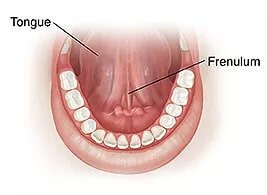ADULT TONGUE TIE SURGERY
“adult Tongue Tie Surgery”
Tongue Tie
Adults Test

ADULT TONGUE TIE (LINGUAL FRENULUM)
Tongue tie, commonly referred to as Ankyloglossia, is a string of tissue called frenulum. This frenulum connects the underside of the tongue to the mouth’s floor and can be seen under the tongue through a mirror. The frenulum tissue can restrict the movements of the tongue and cause speech problems in adults, breathing, swallowing, eating, drinking, chewing, jaw growth, posture, and digestion.

ADULT LIP TIE (LABIAL FRENULUM)
Lip tie is a similar band of tissue, called the labial frenulum, that adheres the lip to the gums at a level much higher than normal. This can lead to a gap in between upper front teeth, cavities, inability to close the lips without strain, and speech difficulties.

ADULT TONGUE TIE CAUSES
ADULT TONGUE TIE SYMPTOMS
- Mouth Breathing
- Noisy breathing or Snoring
- Sleep apnea
- Clenching and grinding their teeth
- Eating slowly or gulping big chunks of food
- Difficulty swallowing or tongue thrusting
- Incorrect facial and jaw development
- Tingling in calves and feet
- Speech problems in adults
- Acid Reflux
- Orofacial pain and TMJ dysfunction
- Headaches, shoulder, neck and back pain
- Tightness in the chest
- Pronated feet
- Deep palate
- Crooked teeth
ADULT TONGUE TIE DIAGNOSIS
Adult tongue ties may be found when looking for causes of TMD/orofacial pain, clenching of teeth, snoring, disturbed sleep and breathing, poorly developed jaw growth, and teeth alignment and speech problems in adults. There are also other signs beyond just the appearance of the tongue on the face and body that only a well-trained professional can assess. Several related issues stem from tongue restriction, including the airway, posture, and sleep, which is why a comprehensive functional assessment of the tongue is essential.
Adult tongue ties may be found when searching for the causes of:
- TMD/orofacial pain
- Clenching of teeth
- Snoring
- Disturbed sleeping
- Breathing issues
- Poorly developed jaw growth and Teeth Alignment
- Speech problems in adults
ANKYLOGLOSSIA TREATMENT ADULTS
such as :
- The patient’s medical history
- Clinical examination
- The severity of the condition

Dr. Shah is the Only
Indian Ambassador of
The Breathe Institute
Procedure by Dr. Soroush Zaghi
RISKS OF AN UNTREATED TIE
- Eating slowly or gulping big chunks of food
- Difficulty swallowing or tongue thrusting
- Incorrect facial and jaw development
- Speech problems
- Acid Reflux
- Orofacial pain and TMJ dysfunction
- Headaches, shoulder, neck and back pain
- Tightness in the chest
- Tingling in calves and feet
- Clenching and grinding their teeth
- Poor quality of life
- Forward neck and shoulder posture
- Moody Behavior
- Anxiety
- Snoring/ Noisy breathing
- Frequent nasal congestion
- Mouth Breathing
- Noisy breathing or Snoring
- Sleep apnea
The above mentioned risks are examples of observed changes in adults. NOT ALL TIES SHOW all the above mentioned risks. It takes an experienced provider to thoroughly investigate the tongue function and symptoms associated with each tie.
Frequently Asked Questions
Adult tongue ties, if left untreated, can give rise to various health complications like speech issues, snoring, sleep problems, breathing difficulties, and more.
No, an adult tongue tie surgery is not the only optional. Dr. Ankita Shah offers laser tongue tie treatment for adult ankyloglossia, which is quick, painless, and offers lifelong results.
Dr. Ankita Shah and her team offer multidisciplinary approaches such as myofunctional therapy and sometimes physical therapy before, during, or after treatment that helps retain muscle, balance, and posture. These comprehensive approaches help overcome speech problems.
OUR ADVANCED & GLOBALLY RENOWNED TONGUE TIE PROCEDURES:
Blogs

The Link Between Tongue Tie and Gastroesophageal Reflux Disease (GERD)
I frequently meet patients who share a common concern: the question of whether their jaw pain,

What Happens If I Don’t Treat My Child’s Tongue-Tie?
As a parent, your child’s health and development are your top priorities. But what if something..

How Do Babies Feed After Tongue-Tie Surgery? A Complete Guide for Parents
When your baby struggles to breastfeed or bottle-feed, it can be very frustrating and emotional

How Tongue Tie Impacts Nutrition and Feeding in Children?
Have you ever noticed your baby struggling to latch while breastfeeding? Or maybe your child..

How Laser Frenectomy Helps Improve Breastfeeding for Newborns?
Breastfeeding is a beautiful and essential bonding experience between a mother and her newborn.

Innovative Advances in Tongue Tie Treatment: What’s New?
A condition known as tongue-tie, or ankyloglossia, limits the range of motion of the tongue.

How Tongue Tie Affects Speech Development in Children and Adults?
Tongue tie, also called ankyloglossia, may seem like a technical word, many adults and parents should..

Tongue Tie Compensations: Fascial Restrictions, Tension And Pain
Fascia is a connective tissue more like a spider web that provides our body a continuous 3-dimensional

6 Steps Of Assessment: Do I Have A Tongue Tie?
The back of the tongue should be resting high up on the palate. This helps in keeping the airway wide open.

What Exactly Is A Tongue Tie? How Does It Affect Us?
#DidYouKnow the tongue has 8 muscles which can exert 500gms of force? We have almost always neglected













